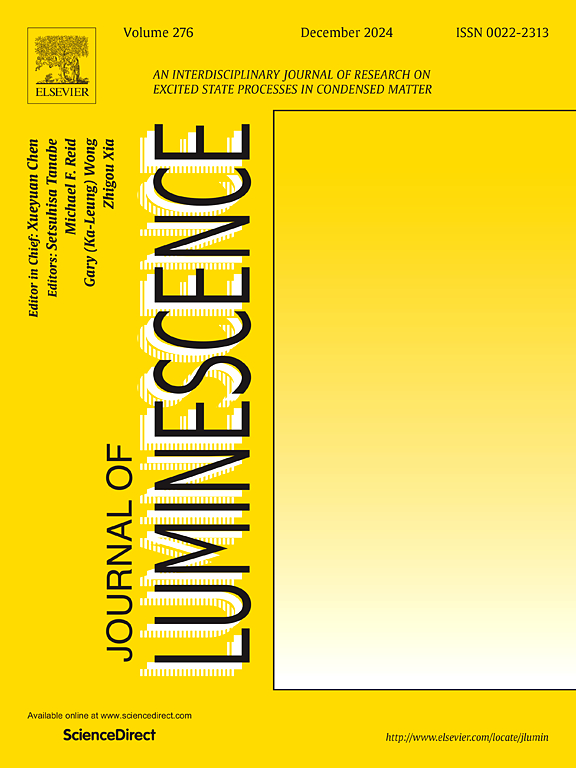Synthesis and spectroscopic analysis in Ca3NbGa3Si2O14: Ln3+(Ln= Sm,Tb) phosphor for optical applications
IF 3.3
3区 物理与天体物理
Q2 OPTICS
引用次数: 0
Abstract
The orange red emitting Ca3NbGa3Si2O14: Sm3+, Tb3+ phosphor was synthesized by solid-state reaction (SSR) method at 1280 °C for 10 h followed by annealing at 400 °C for 7hrs. X-ray diffraction pattern confirms the hexagonal structure with P321(No.150) space group. Compound formation, elemental analysis, photoluminescence and energy transfer mechanism from Tb3+ to Sm3+ were studied. Ca3NbGa3Si2O14:Sm3+ phosphor exhibits orange-red emission at 601 nm attributed to 4G5/26H7/2 transition. Ca3NbGa3Si2O14:Tb3+ phosphor exhibits green emission at 544 nm attributed to 5D4 7F5 transition. The optimum concentration for Sm3+ and Tb3+ is found to be 3.0 and 2.0 mol. % respectively. Lifetime decay measurements of Tb3+ confirms the energy transfer mechanism which was proved to be a quadrupole-quadrupole interaction. The CIE chromaticity coordinates calculated for Sm3+ (0.63, 0.37), Tb3+ (0.27, 0.72) and 2.0 Tb3+, ySm3+ (0.37, 0.40) suggests its potential use for fabrication of optical devices. Higher values of Ω4 indicate centro-symmetric character of the field experienced by Sm3+ ions. This confirms that magnetic dipole transitions are dominant over electric dipole transitions which are analogous to the PL results. Since the obtained values of the branching ratios with respect to transition, 4G5/2 6H7/2 are around 50 %, this material can be proposed as a potential laser material having emission wavelength around 601 nm.

光学用Ca3NbGa3Si2O14: Ln3+(Ln= Sm,Tb)荧光粉的合成与光谱分析
采用固态反应(SSR)方法,在1280℃下反应10 h,在400℃下退火7h,合成了橙红色发光的Ca3NbGa3Si2O14: Sm3+, Tb3+荧光粉。x射线衍射图证实其具有P321(No.150)空间群的六边形结构。研究了Tb3+到Sm3+的化合物形成、元素分析、光致发光和能量传递机理。Ca3NbGa3Si2O14:Sm3+荧光粉由于4G5/2→6H7/2跃迁,在601 nm处呈现橙红色发光。由于5D4→7F5跃迁,Ca3NbGa3Si2O14:Tb3+荧光粉在544 nm处呈现绿色发光。Sm3+和Tb3+的最佳浓度分别为3.0和2.0 mol. %。Tb3+的寿命衰减测量证实了能量传递机制,该机制被证明是四极-四极相互作用。计算的Sm3+ (0.63, 0.37), Tb3+(0.27, 0.72)和2.0 Tb3+, ySm3+(0.37, 0.40)的CIE色度坐标表明其在光学器件制造中的潜在用途。Ω4值越高,表明Sm3+离子经历的场具有中心对称特征。这证实了磁偶极子跃迁比类似于PL结果的电偶极子跃迁占主导地位。由于得到的4G5/2→6H7/2的分支比相对于跃迁的值约为50%,因此可以提出该材料为发射波长约为601 nm的潜在激光材料。
本文章由计算机程序翻译,如有差异,请以英文原文为准。
求助全文
约1分钟内获得全文
求助全文
来源期刊

Journal of Luminescence
物理-光学
CiteScore
6.70
自引率
13.90%
发文量
850
审稿时长
3.8 months
期刊介绍:
The purpose of the Journal of Luminescence is to provide a means of communication between scientists in different disciplines who share a common interest in the electronic excited states of molecular, ionic and covalent systems, whether crystalline, amorphous, or liquid.
We invite original papers and reviews on such subjects as: exciton and polariton dynamics, dynamics of localized excited states, energy and charge transport in ordered and disordered systems, radiative and non-radiative recombination, relaxation processes, vibronic interactions in electronic excited states, photochemistry in condensed systems, excited state resonance, double resonance, spin dynamics, selective excitation spectroscopy, hole burning, coherent processes in excited states, (e.g. coherent optical transients, photon echoes, transient gratings), multiphoton processes, optical bistability, photochromism, and new techniques for the study of excited states. This list is not intended to be exhaustive. Papers in the traditional areas of optical spectroscopy (absorption, MCD, luminescence, Raman scattering) are welcome. Papers on applications (phosphors, scintillators, electro- and cathodo-luminescence, radiography, bioimaging, solar energy, energy conversion, etc.) are also welcome if they present results of scientific, rather than only technological interest. However, papers containing purely theoretical results, not related to phenomena in the excited states, as well as papers using luminescence spectroscopy to perform routine analytical chemistry or biochemistry procedures, are outside the scope of the journal. Some exceptions will be possible at the discretion of the editors.
 求助内容:
求助内容: 应助结果提醒方式:
应助结果提醒方式:


